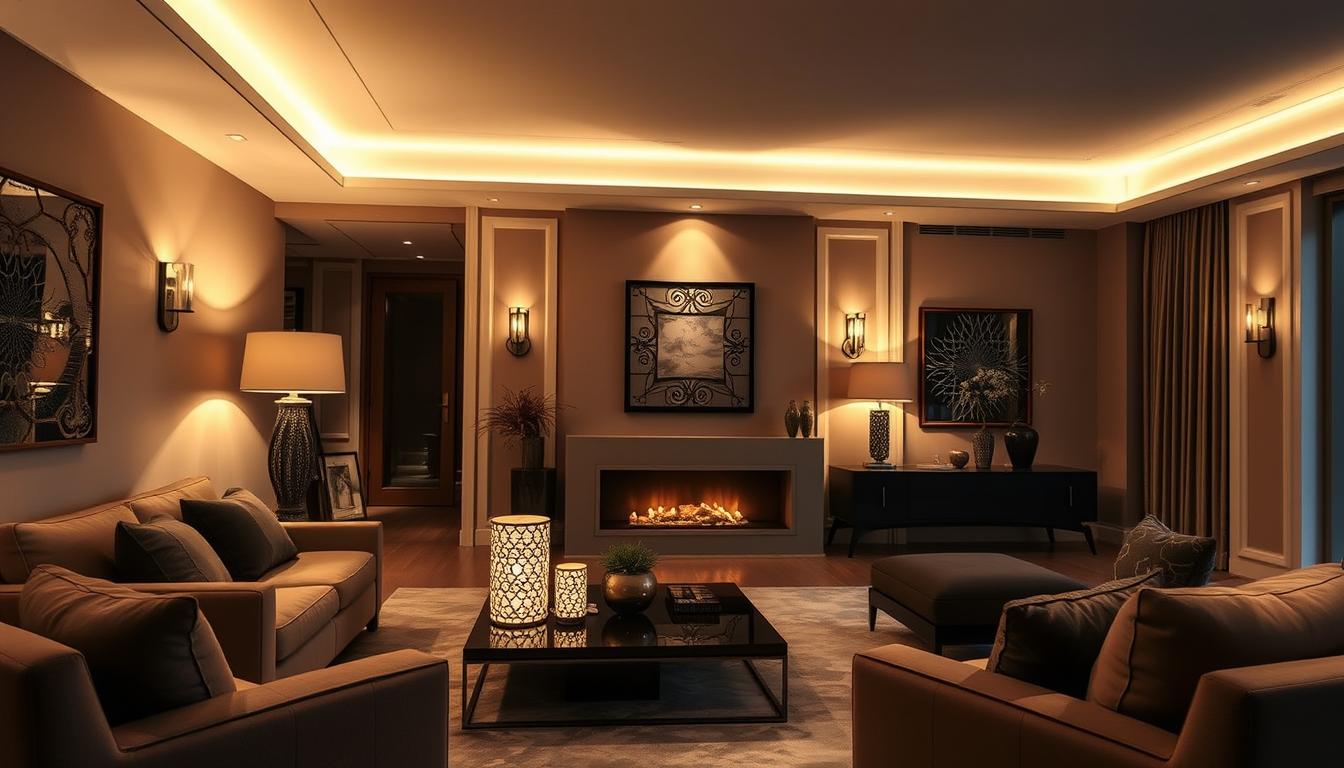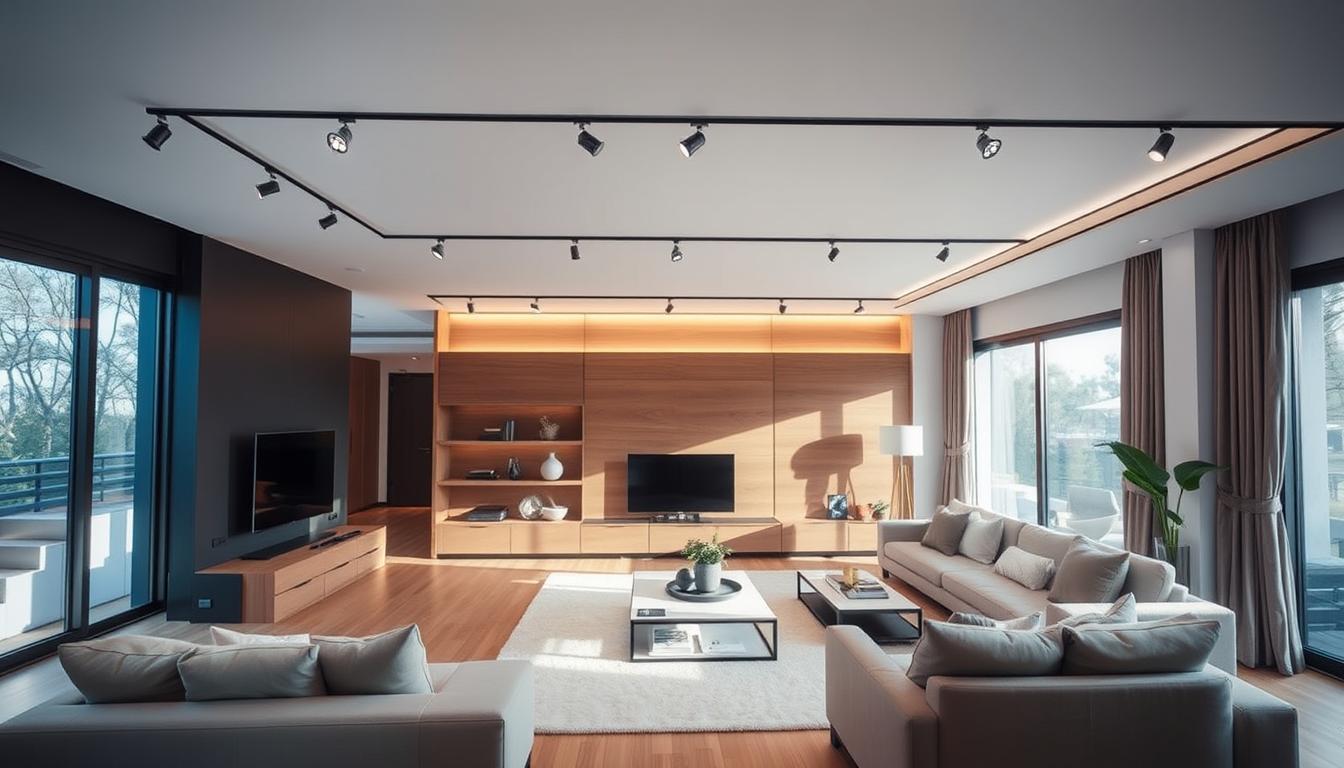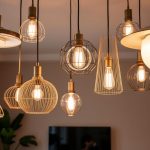Accent lighting is a key part of interior design. It focuses on certain features or areas in a home, making them stand out. This creates focal points that improve the look of the space. By using decorative lighting, homeowners can make their homes more appealing and welcoming.
Using accent lighting wisely can change how a home feels. It draws the eye to special areas or features, like architectural details or artwork. With the right lighting, any room can become a stunning and cozy place.
Key Takeaways
- Accent lighting can create focal points that enhance the overall aesthetic of a room.
- Decorative lighting can be used to highlight architectural details, artwork, or specific design elements.
- Strategic accent lighting can elevate the aesthetic of any room.
- Understanding how to use accent lighting effectively is essential for homeowners and designers.
- Accent lighting can direct attention to specific areas or features within a home.
- Decorative lighting can transform any room into a beautiful and inviting space.
Understanding the Power of Accent Lighting
Accent lighting is a special part of lighting design. It shines light on specific objects or areas, making a space look better. This technique not only shows off the beauty of a room but also changes the mood and feel of it. By knowing how focused light works, people can use accent lighting to make a space look its best.
For example, art lighting can make certain art or architectural details stand out. This is great in places like living rooms or bedrooms where mood is key. By placing accent lights carefully, people can make a room feel balanced and harmonious. It guides the eye to the most interesting parts of the room.
- Directing light onto specific objects or areas to create a visual hierarchy
- Using art lighting to draw attention to specific pieces of art or architectural features
- Creating a sense of balance and harmony through strategic placement of accent lights
By using these ideas in their lighting design, people can make a space that looks good and works well. Accent lighting is key in creating the right mood and highlighting the best parts of a room.
Essential Elements of Effective Accent Lighting Design
Designing accent lighting involves several important elements. Lighting techniques like layering light and using dimming options can greatly improve accent lighting’s impact. By understanding these design elements, you can make accent lighting that looks good and works well.
To get the most out of accent lighting, picking the right fixtures, finding the perfect light intensity, and thinking about color temperature are key. Here are some main points to keep in mind:
- Layering light to create depth and visual interest
- Using dimming options to adjust light levels and mood
- Selecting lighting fixtures that complement the space and desired ambiance
By using these lighting techniques and design elements in your accent lighting design, you can make a space that’s both beautiful and useful. Think about the look you want to achieve and how lighting techniques can help you get there.
Good accent lighting design is about finding a balance between looks and function. By focusing on the key design elements and lighting techniques, you can create a space that’s both eye-catching and practical.
Types of Accent Lighting Fixtures and Their Applications
Choosing the right accent lighting fixture can really make a room pop. It’s all about creating decorative lighting that highlights specific focal points. With many options out there, knowing what each fixture does is key.
Accent lighting can add anything from a soft glow to a bold statement. The right fixture can make your space both stunning and practical. Here are some popular choices:
- Track lighting systems, which offer flexibility and can be used to highlight multiple objects or areas
- Recessed directional lights, which provide a sleek, minimalist look while focusing light precisely where needed
- Wall-mounted sconces, which can add a decorative touch while serving as accent lights
- Picture and art lights, which are specially designed to light up framed pieces without causing glare
Knowing how each fixture works helps you make smart choices. Whether you want a cozy vibe or to spotlight something special, the right accent lighting can help.
With the right mix of decorative lighting and accent fixtures, your home can look amazing and work well. By picking the right fixtures, you can make your home’s lighting enhance its beauty and highlight your favorite focal points.
Highlighting Architectural Features in Your Home
The right lighting can really make your home stand out. It can highlight the best parts of your space, like exposed beams or textured walls. This adds depth and interest, and even sets the mood for your home.
Choosing the right lighting is key. Directed light can focus on certain features, while soft glow creates a softer feel. Here are some ways to light up your home:
- Use track lighting on beams or columns.
- Install recessed lights for textured walls or arches.
- Place wall sconces for a warm glow.
Lighting can make your home look and feel amazing. It can be used to create a stunning focal point or just to make a room feel cozier. By using light to highlight your home’s features, you can make it truly special.
Creating Dramatic Focal Points Through Light
Accent lighting is a great way to make a room stand out. By placing lights carefully, you can focus on certain parts of the room. This could be texture, color, or pattern. You can use bright lights, play with light and shadow, or arrange things in a way that catches the eye.
Here are some tips for making focal points:
- Put lights where they highlight design elements
- Choose bright lights to grab attention
- Play with light and shadow for depth
Design magazines and blogs say adding texture, color, and pattern makes focal points pop. For instance, a big art piece or a textured wall can be the room’s center when lit up right.
With the right lighting, you can make a room’s best features shine. It could be a beautiful art piece, a cool architectural detail, or a standout piece of furniture. Accent lighting brings drama and focus to any space.
| Design Element | Lighting Technique | Effect |
|---|---|---|
| Texture | Accent lighting | Highlights texture, adds depth |
| Color | Colored lighting | Creates visual interest, adds emotion |
| Pattern | Contrasting light and shadow | Adds dimension, creates visual hierarchy |
Room-by-Room Guide to Accent Lighting Implementation
Accent lighting is key to making each room in your home special. It’s about using the right lighting to make your space warm and inviting. Accent lighting can highlight design features, create a cozy feel, and even make rooms look bigger.
In the living room, accent lighting can focus on entertainment areas or special decor. Decorative lighting like table lamps or floor lamps can add elegance. Bedrooms benefit from soft, warm lighting, perfect for relaxing.
Lighting Strategies for Different Rooms
- Living Room: Use accent lighting to highlight entertainment areas or decorative pieces
- Bedroom: Create a cozy atmosphere with soft, warm accent lighting
- Kitchen and Dining Area: Use accent lighting to draw attention to design features or create ambiance during meals
- Outdoor Spaces: Highlight architectural features or garden elements with accent lighting
Knowing how to light each room can make your home feel welcoming. Accent lighting can turn a simple room into a cozy reading spot or a lively entertainment area. With the right lighting, your home can become truly special.
Technical Considerations for Perfect Accent Lighting
Getting perfect accent lighting involves several key points. It’s important to know about lighting techniques like lumen output, color temperature, and beam angle. These help create a stunning and well-designed lighting setup.
When planning your lighting, think about the type of fixture, its placement, and how to control the light. For instance, dimming options can change the mood from soft to bright. By picking and placing lights wisely, you can make your space look better.
To get the best lighting techniques and design elements, follow these steps:
- Figure out what you want your space to look like
- Pick lights that match your style and needs
- Place lights to highlight and shadow just right
- Use dimmers to adjust the light and mood
By being careful and informed in your lighting choices, you can make a space that looks great and works well. This will make your space more enjoyable.
Common Accent Lighting Mistakes to Avoid
Accent lighting can greatly change a room’s feel. Even small mistakes can affect how a room looks. Knowing common errors helps avoid them and makes your lighting design better.
One big mistake is placing lights wrong. This can cause bad shadows or not enough light. It’s hard to show off decorative lights or focal points if the lighting is off.
Improper Positioning
Fixing this mistake takes planning. Think about the room’s size and shape. Also, where your decorative lights or focal points are.
Overlooking Dimming Options
Not using dimmers is another mistake. It can make lights too bright or too dim. Dimmers let you change the light to fit different moods or activities.
Balance and Proportion Errors
Lastly, wrong balance and size can mess up a room’s look. It makes accent lighting look out of place. Make sure your room’s balance and size match your lighting and focal points.
Knowing these mistakes helps you make great accent lighting. It will highlight your decorative lights and focal points beautifully.
Conclusion: Illuminating Your Space with Purpose
Strategic accent lighting is a game-changer for any space. It lets homeowners highlight their home’s best features. This technique also helps create the perfect mood and guides the eye.
Looking to make architectural details stand out or set a certain vibe? The right accent lighting can do it all. Now, you know how to light up your home beautifully and functionally.
Let your creativity flow with strategic accent lighting. Make your living spaces shine, set the mood just right, and show off your home’s unique style. Start with one fixture at a time.



